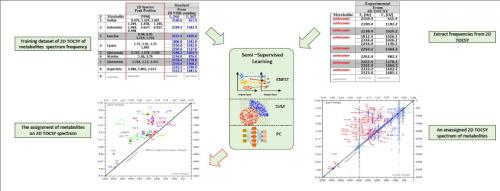当前位置:
X-MOL 学术
›
Comput. Struct. Biotechnol. J.
›
论文详情
Our official English website, www.x-mol.net, welcomes your
feedback! (Note: you will need to create a separate account there.)
Automated metabolic assignment: Semi-supervised learning in metabolic analysis employing two dimensional Nuclear Magnetic Resonance (NMR)
Computational and Structural Biotechnology Journal ( IF 4.4 ) Pub Date : 2021-08-31 , DOI: 10.1016/j.csbj.2021.08.048 Lubaba Migdadi 1, 2 , Jörg Lambert 1 , Ahmad Telfah 1 , Roland Hergenröder 1 , Christian Wöhler 2
Computational and Structural Biotechnology Journal ( IF 4.4 ) Pub Date : 2021-08-31 , DOI: 10.1016/j.csbj.2021.08.048 Lubaba Migdadi 1, 2 , Jörg Lambert 1 , Ahmad Telfah 1 , Roland Hergenröder 1 , Christian Wöhler 2
Affiliation

|
Metabolomics is an expanding field of medical diagnostics since many diseases cause metabolic reprogramming alteration. Additionally, the metabolic point of view offers an insight into the molecular mechanisms of diseases. Due to the complexity of metabolic assignment dependent on the 1D NMR spectral analysis, 2D NMR techniques are preferred because of spectral resolution issues. Thus, in this work, we introduce an automated metabolite identification and assignment from H-H TOCSY (total correlation spectroscopy) using real breast cancer tissue. The new approach is based on customized and extended semi-supervised classifiers: KNFST, SVM, third (PC3) and fourth (PC4) degree polynomial. In our approach, metabolic assignment is based only on the vertical and horizontal frequencies of the metabolites in the H–H TOCSY. KNFST and SVM show high performance (high accuracy and low mislabeling rate) in relatively low size of initially labeled training data. PC3 and PC4 classifiers showed lower accuracy and high mislabeling rates, and both classifiers fail to provide an acceptable accuracy at extremely low size (≤9% of the entire dataset) of initial training data. Additionally, semi-supervised classifiers were implemented to obtain a fully automatic procedure for signal assignment and deconvolution of TOCSY, which is a big step forward in NMR metabolic profiling. A set of 27 metabolites were deduced from the TOCSY, and their assignments agreed with the metabolites deduced from a 1D NMR spectrum of the same sample analyzed by conventional human-based methodology.
中文翻译:

自动代谢分配:利用二维核磁共振 (NMR) 进行代谢分析的半监督学习
代谢组学是一个不断扩展的医学诊断领域,因为许多疾病会导致代谢重编程改变。此外,代谢的观点提供了对疾病分子机制的深入了解。由于代谢分配的复杂性取决于 1D NMR 光谱分析,因此由于光谱分辨率问题,优选 2D NMR 技术。因此,在这项工作中,我们引入了使用真实乳腺癌组织的 HH TOCSY(全相关光谱)的自动代谢物识别和分配。新方法基于定制和扩展的半监督分类器:KNFST、SVM、三次 (PC3) 和四次 (PC4) 多项式。在我们的方法中,代谢分配仅基于 H-H TOCSY 中代谢物的垂直和水平频率。 KNFST 和 SVM 在相对较小的初始标记训练数据中表现出高性能(高精度和低误标记率)。 PC3 和 PC4 分类器表现出较低的准确度和较高的错误标记率,并且两个分类器都无法在初始训练数据规模极小(≤整个数据集的 9%)时提供可接受的准确度。此外,还实施了半监督分类器以获得 TOCSY 信号分配和反卷积的全自动程序,这是 NMR 代谢分析的一大进步。从 TOCSY 中推导出一组 27 种代谢物,它们的分配与通过传统的人类方法分析的同一样品的 1D NMR 谱推导出的代谢物一致。
更新日期:2021-08-31
中文翻译:

自动代谢分配:利用二维核磁共振 (NMR) 进行代谢分析的半监督学习
代谢组学是一个不断扩展的医学诊断领域,因为许多疾病会导致代谢重编程改变。此外,代谢的观点提供了对疾病分子机制的深入了解。由于代谢分配的复杂性取决于 1D NMR 光谱分析,因此由于光谱分辨率问题,优选 2D NMR 技术。因此,在这项工作中,我们引入了使用真实乳腺癌组织的 HH TOCSY(全相关光谱)的自动代谢物识别和分配。新方法基于定制和扩展的半监督分类器:KNFST、SVM、三次 (PC3) 和四次 (PC4) 多项式。在我们的方法中,代谢分配仅基于 H-H TOCSY 中代谢物的垂直和水平频率。 KNFST 和 SVM 在相对较小的初始标记训练数据中表现出高性能(高精度和低误标记率)。 PC3 和 PC4 分类器表现出较低的准确度和较高的错误标记率,并且两个分类器都无法在初始训练数据规模极小(≤整个数据集的 9%)时提供可接受的准确度。此外,还实施了半监督分类器以获得 TOCSY 信号分配和反卷积的全自动程序,这是 NMR 代谢分析的一大进步。从 TOCSY 中推导出一组 27 种代谢物,它们的分配与通过传统的人类方法分析的同一样品的 1D NMR 谱推导出的代谢物一致。











































 京公网安备 11010802027423号
京公网安备 11010802027423号